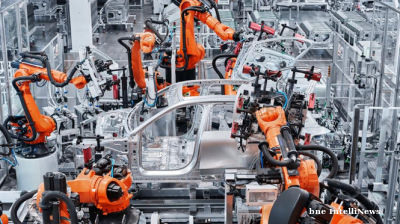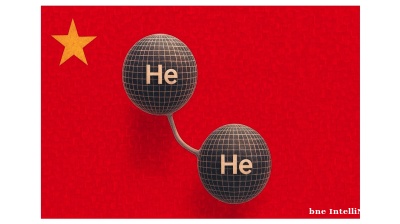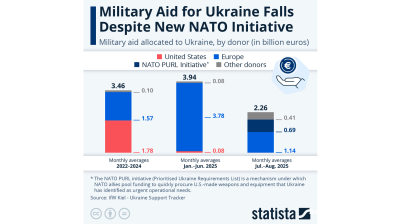Advanced machinery imports from China to Russia soar tenfold, Russia’s technology remains impossibly far behind that of the West

Deliveries of advanced machinery and technology from China to Russia have soared tenfold, the Financial Times reported on January 3.
The twelve packages of sanctions on Russia have targeted technology in an effort to cut the country’s productive power and hamper its ability to wage war on Ukraine. In particular, the West hoped to cut Russia off from access to the advanced microchips needed to make new smart missiles it has been using against Ukrainian infrastructure facilities. But as bne IntelliNews has reported, the technology sanctions have completely failed, as Russia is importing more technology than it did before the war started via third parties in friendly countries.
Most of that technology is coming from China, the FT reports, which has become a major supplier of machines and technology to Russia. However, in order to avoid bringing down sanctions on itself, Beijing has been careful not to export military technology explicitly but is instead exporting technology and machinery with dual-use capabilities, according to reports.
Amongst the products China is selling to Russia are microchips, manufactured in China, where exports have surged tenfold since the start of 2022.
Russia's demand for microchips and advanced machine tools, crucial for producing missiles, drones and other sophisticated military items, has ballooned.
As bne IntelliNews reported two years ago, Russia’s lack of precision tools has long been its sanctions soft underbelly. The timing of the collapse of the Soviet Union in 1991 came at an unfortunate moment, as during the following decade of economic chaos Russia missed out on two revolutions in the making of precision tools, bne IntelliNews reported in a deep dive into Russia’s machine tool sector. In the last thirty years new technology has appeared such as the computer-run “mechatronics” and the “five axis grinders” amongst other things that Russia is far away from being able to make itself, and this left it impossibly far behind the rest of the developed world in terms of technology.
Before the war in Ukraine started, Russia was already trying to diversify its supplies of tools and technology away from the world leaders in tool and tech production, German, Japan and the US, and turning to China as a major alternative supplier. However, while China did significantly increase its exports to Russia, the level of its technology remained lower than that of the Western suppliers. While the volumes of technology from China soared, Russia remained heavily dependent, and still does, on the West for the most sophisticated technology and hi-tech materials.
Nevertheless, the gap between China and the West is closing steadily, partly thanks to China’s heavy investment into R&D to catch up and its “turtles” programme, where it has been actively recruiting researchers of Chinese ethnic origin that have been working in Western labs and throwing money at setting up its own research facilities.
And the effort is already paying dividends. Beijing recently unveiled a commercial 7nm chip in a mobile phone that Western experts thought China was years away from developing. The gap remains, as the US is currently developing a 4nm chip, but the new Chinese 7nm chip already represents significant progress.
In response to the tech arms race, the US recently introduced the CHIPS legislation that effectively banned all exports of the highest tech to China and threatened US nationals working in China for Chinese companies with the loss of citizenship if they didn’t leave the country immediately.
But despite the progress, China is still behind the US in many areas. In December the US also slapped new sanctions on the Arctic LNG-2 project, a new plant to produce liquefied natural gas (LNG) owned by the Russian company Novatek. Russia already produces 33mn tonnes per year of LNG but had hoped to triple LNG production to 100mn tpy by 2030 and increase its share of the global business from 8% now to 20% by the end of the decade.
Here too, the US is using the sanctions to protect its market share and take out a rival as the US overtook Qatar in December to become the world’s biggest LNG exporter. The US now supplies 40% of Europe’s LNG imports from a standing start in 2016, when LNG exports began.
The sanctions on Arctic LNG-2 have caused Novatek a serious problem, as while China can provide many of the components for the new plant, there are some crucial components that are only made by a handful of Western companies that can no longer supply the Russian company. Novatek issued a force majeure warning in December to clients, saying deliveries of LNG slated to be dispatched in the first quarter of this year are now likely to be delayed as a result of the sanctions.
While the US aims to restrict the flow of high-tech goods to Russia, China, being a major producer of microchips and rare earth minerals, is Moscow's largest trading partner. Putin is betting that in the long term China will continue to close its technology gap with the US and increasingly be able to meet Russia’s technology needs, but make Moscow more dependent on Beijing in the process.
Despite Beijing's assertion that it doesn't provide lethal aid to Moscow, its shipments encompass various products, including energy, machinery, consumer goods, industrial tools and cars, contributing to Russia's economic resilience against Western sanctions.
Washington appears hesitant to impose financial sanctions on Chinese companies aiding Russia, fearing the potential initiation of another global trade war.
Tech

China increasing its lead in robot technology use
China is consolidating its dominance in the global industrial robotics market, accounting for 41% of the world’s operational robot stock and more than half of all new installations in 2024, according to the International Federation of Robots.

The Iranian inventor that invented the floating shoes, has now built a propeller-less propulsion system ideal for flying taxis
Mohsen Bahmani is an Iranian-born mechanical engineer and a man with a dream. When he was just 17 years old, he made a pair of floating shoes that allow you to walk on water. Now he has built a propulsion system ideal for flying taxis.
_(1).jpg)
OpenAI to invest up to $25bn in Argentina under Milei incentive scheme
Artificial intelligence giant OpenAI and energy company Sur Energy have signed a letter of intent to develop a data centre hub in Argentina requiring investment of up to $25bn.

Helium was China's rare earth metals Achilles' heel
China has a devastating tool in its escalating trade war with the US: rare earth metals (REMs). Last week, Beijing announced new restrictive export controls on the export of anything with even a smidgen of Chinese-produced REMs.



